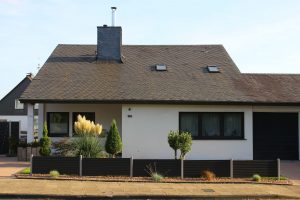 Soft tile is valued all over the world as a reliable and elegant roof covering.
Soft tile is valued all over the world as a reliable and elegant roof covering.
It is safe to say that soft tile is on par with metal roofing. The roofs of houses with such a roof look stylish and especially harmonious against the background of the surrounding nature.
Flexible approach: what is a soft tile?
In the United States, 90% of American homes are covered with bituminous shingles, and Americans are rightly called the legislators of roofing fashion. And it was there that such roofing first appeared – in North America, under the name “shingle”, which means something assembled from individual elements.
Today, soft tiles have a different composition and are available in a variety of versions: single-layer, multilayer, and even copper.
Different manufacturers offer their composition of shingles, shapes, and colors. That is why the structure of roof tiles is so different, but a standard one-sheet (shingles) usually has 6 layers.
The upper decorative is formed by basalt granulation, shale, or mineral crumb. All this gives the main color shade and design of the roof. In addition, the decorative layer also protects against noise, sunlight, and precipitation.
Next is a bituminous layer, with various polymer additives. Its main task is to give the flexibility and resistance of the tile to deformation.
Next is the base – organic cellulose or fiberglass cloth impregnated with bitumen. Their mission is to ensure the stability of shingles.
Now again a layer of bitumen with polymers or a self-adhesive basis is an additional aspect.
Finally, a transparent film to protect this adhesive layer, so that in the process of transportation shingles do not stick to others.
High-quality soft tiles can withstand temperatures from -50 to 110F°, ultraviolet light, and heavy snow, well protect the room under the roof from cold and heat.
Production technology
If you are holding a sample of a soft roof, listen: the smell of shingles indicates the quality of the bitumen. If sharp, it indicates the active evaporation of substances, which means that such shingles will quickly lose their elasticity. Also, if the soft tile is low quality, the granulate crumbles, and noticeably. After all, “bald” bitumen is not adapted to withstand destructive ultraviolet light. According to the group of flammability, soft tiles belong to B1 and B2.
Therefore, if the soft tile is of good quality and from a proven manufacturer, it is completely fireproof, even though it is made of bitumen. So, if you like modern soft tiles, choose a good manufacturer and put it on the roof without any worries.
Types and forms of shingles
All types of bituminous shingles are classified according to several criteria. The first of them is the number of layers: there are single-layer, two-layer, and three-layer tiles. Sometimes two-layer and three-layer tiles are called “laminated”, and this coating is more resistant to wind and moisture.
The main advantage of multilayer shingles is that it is thicker and stronger than a one-layer coating. It is more difficult to pierce or damage this tile during the operation and installation of the roof. Multilayer tiles successfully withstand even hurricane winds up to 150 km/h, which breaks easily the slate and metal.
Picture Credit: Unsplash
